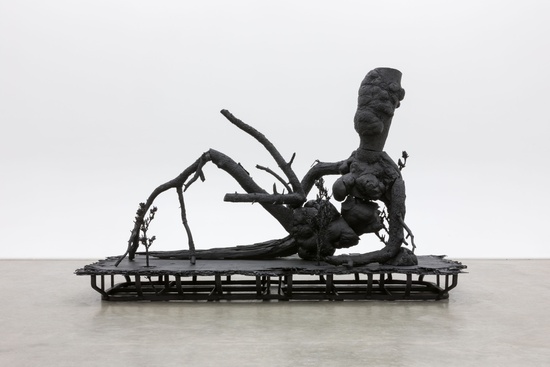Matthew Day Jackson’s interdisciplinary practice explores a myriad of aspects of human experience and draws from sources that reveal both our intrinsic inventiveness and its counter-point, our ongoing capacity for destruction.
The exhibition will feature an entirely new series of still life paintings and bronze sculpture. As Jackson explains, ‘I am interested in exploring how certain ideas, forms, images, narrative structures and traditions are manifest in the present. The process by which they are severed and dismembered from the past is how they are enlivened.’ Utilising the conventions of still life and the reclining nude figure in combination with a precise use of material and form, Jackson critiques these traditions, their cultural placement and his own authorship in relation to these ways of working.
The series of still life ‘paintings’ are direct representations of Jan Brueghel the Elder’s and Younger’s genre-defining series of flower paintings from the 16th and 17th centuries, made during a time of Dutch colonial expansion and exploitation. The significance of these works for the artist is their simultaneously beguiling and prosaic qualities; they are both an exuberant expression of nature’s bounty and a visual manifestation of power and wealth. While the era was one of burgeoning scientific knowledge, Jackson signals the pitfalls of the ceaseless misuse and abuse of the natural world. This concern ties into the American environmental movement and issues of sustainability that have been explored in Jackson’s previous works. If Brueghel’s paintings are a celebration of nature as a divine gift to humanity, Jackson presents an alternative to this view since for the artist, ‘each work is a meditation on exploration, the past found in the present, and is a critical discourse of technology and our persistent tendencies to open Pandora’s Box.’
Throughout Jackson’s oeuvre, process and materiality as a conduit for meaning have been a recurrent theme. The flower ‘paintings’ are entirely composed of artificial and manufactured materials such as Formica, plywood and epoxy. These materials have a personal resonance for Jackson and are imbued with memories from his past and his own ‘American experience’. The use of these substances is a meditation on the domestic environment, aspiration, class and impermanence. In ‘Bouquet of Flowers in a Vase’ (2017), Jackson encloses the delicate form of the screen-printed and in-laid flora within a poured lead surround. This metal has associations of poison or death and, in this manner, the artist signals a memento mori ingrained in the fabric of the work itself.
See also Lorna Simpson: Unanswerable 1 March – 28 April, Hauser and Wirth
| Duration | 01 March 2018 - 28 April 2018 |
| Times | Tuesday – Saturday 10 am – 6 pm |
| Cost | Free |
| Venue | Hauser & Wirth (London) |
| Address | 23 Savile Row, London, W1S 2ET |
| Contact | / london@hauserwirth.com / www.hauserwirth.com |

